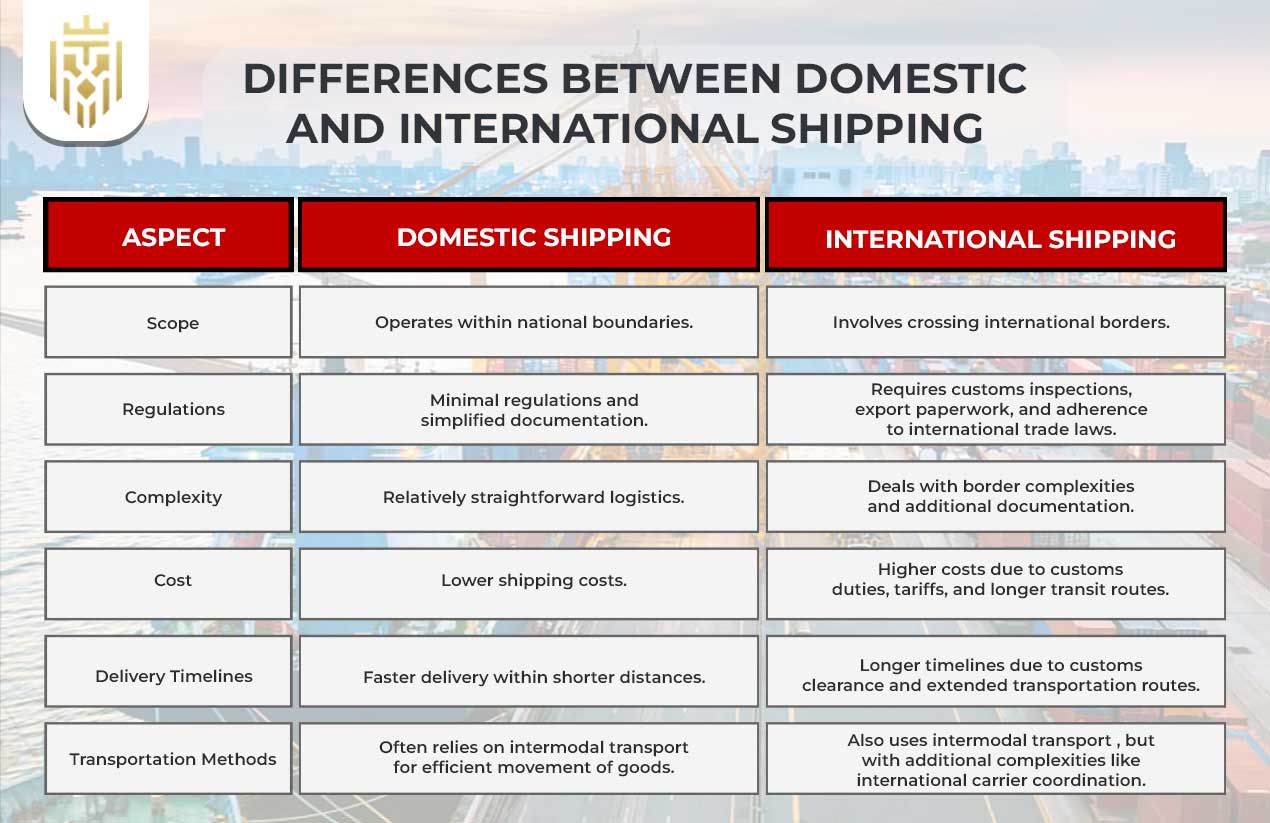What is Domestic Shipping?
Domestic shipping is the transportation of goods or documents on a national basis, including the transportation between any territories. For example, shipping of items from mainland India to Andaman Islands is under domestic shipping services, since the shipping falls within the jurisdiction of National. Domestic expedited shipping ensures a faster delivery in the country’s borders, while having flexible options for urgent delivery.
Why is Domestic Shipping Beneficial?
Domestic shipping services are the most important part of business operations since it allows good connections between regions without customs clearance delays. The documentation required is lower than international logistics. Transportation management systems use to optimise the routes of shipping and ensure timely delivery.

How Long does Domestic Shipping Take to Deliver?
Delivery times for domestic shipping depend on methods like standard or express shipping. For example, domestic expedited shipping takes 1–3 days, while standard delivery takes 2–8 days. Costs depend on speed, weight, and additional services, especially in competitive shipping and logistics markets.
Difference between Domestic and International Shipping:
Domestic shipping stays within national boundaries, involving minimal regulations and simplified documentation. In contrast, international logistics deals with customs inspections, export paperwork, and border complexities. Both rely on intermodal transport for efficiency, but international shipping often has higher costs and longer timelines.

Domestic Shipping Process:
The domestic shipping process involves order receiving, processing, fulfilment, and delivery. It ensures efficient movement of goods within a country using optimised logistics solutions like intermodal transport and transportation management systems for seamless operations.
Order Receiving:
The domestic shipping process starts with receiving orders, which involves pre-shipment, shipment, and post-shipment management for returns. A streamlined process ensures all tasks, from order placement to delivery, are managed efficiently through a transportation management system.
Processing the Order:
Order processing includes inventory checks, secure packaging, and carrier selection based on timelines and customer requirements. Efficient integration of multimodal transport ensures the timely delivery of shipments across multiple transport modes, enhancing operational flexibility.
Order Fulfilment:
Order fulfilment ensures smooth delivery through structured receiving, processing, and dispatching stages. Integrating shipping and logistics systems with real-time updates enhances customer satisfaction and supports domestic shipping services.
Domestic Shipping Charges and Factors:
Domestic shipping charges are influenced by distance, weight, freight density, demand, and transport mode. Efficient planning, such as using multimodal transport, ensures cost-effective delivery and supports faster shipping for varying customer needs.
Distance:
As distance increases, so do the shipping charges, as longer distances often require intermodal transport to be cost-efficient. Intra state deliveries are shorter and therefore more economical than long haul shipments. Proximity based routing is used by domestic shipping services to optimize their pricing.
Weight:
Actual weight, dimensional weight and package size determine shipping charges. For expedited shipping services, which prioritise speed, the higher the weight, the higher the transport cost. In domestic shipping v/s international comparisons, it’s often the dimensional weight that becomes a key factor.
Freight Density:
Classification and cost are affected by freight density. Efficient use of space makes higher density shipments more economical. In shipping and logistics, this parameter is important because it balances weight, volume and transportation cost.
Freight Demand:
During high demand season like festivals, shipping rates rise as capacity tightens. Transportation management systems aid in efficient demand forecasting, and thus helping businesses to overcome fluctuations in domestic shipping cost.
Mode Of Transport:
Costs and timelines vary based in shipping modes. Flexibility of multimodal transport relies on the combination of air, road and rail, while intermodal transport relies on the use of standardised containers. Road and rail are most cost effective for regional shipments, but air transport is fastest.
FAQs
-
What is Domestic Shipping?
Domestic shipping refers to transporting goods within a country’s borders, including territories. It excludes customs regulations, offering faster delivery times and simpler processes than international logistics, ideal for nationwide shipping and logistics solutions.
-
How long does domestic shipping take to deliver?
Delivery times for domestic shipping services vary by method: domestic expedited shipping takes 1–3 days, while standard services require 2–8 days. Factors like distance, weight, and additional services influence delivery speed and cost.
-
What’s the difference between domestic and international shipping?
Domestic shipping operates within a country, with fewer regulations, lower costs, and faster delivery. International logistics involves customs clearance, higher charges, and longer timelines, often requiring advanced shipping and logistics coordination for smooth operations.
-
What Are Domestic Shipping Charges and the Factors?
Domestic shipping charges depend on distance, weight, freight density, demand, and transport mode. Factors like intermodal transport and seasonal demand influence costs, emphasising efficient transportation management systems to optimize logistics and pricing.







